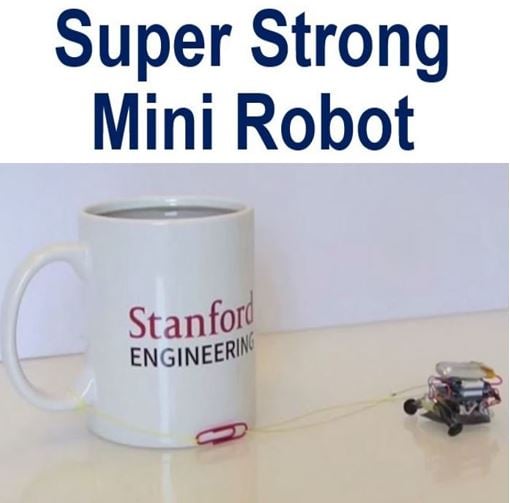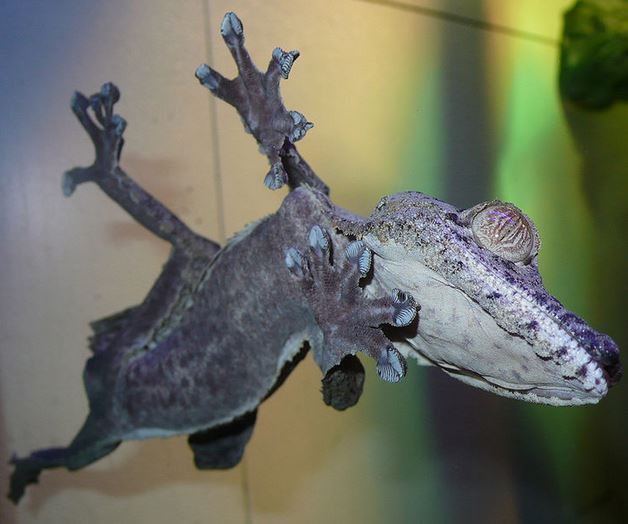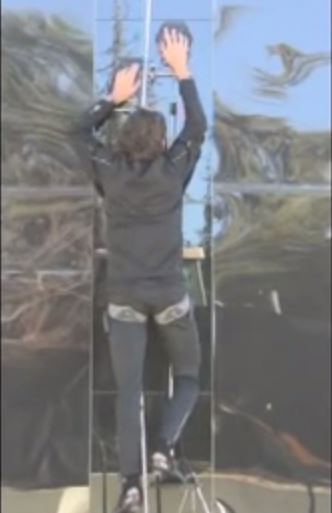A series of super strong mini robots has been created by Stanford University engineers that climb walls gecko-style carrying and pulling things 100 times their own weight. Elliot Hawkes and colleagues will present their mighty bots at the International Conference on Robotics and Automation, Seattle, Washington, in May.
Geckos can climb walls as easily as walking on a flat surface, because of the controllable adhesion they have in their feet. Each gecko toe is covered in lamellae (flaps of skin), which are covered in arrays of setae (microscopic hair-like structures).
The mini robots’ synthetic feet have tiny rubber spikes which grip firmly onto walls as they climb.

A mighty bot pulling a mug full of coffee. (Image: New Scientist YouTube Video)
When pressure is applied, i.e. when the feet touch a surface, the spikes bend, thus increasing their surface area, making them super-sticky. When the robot lifts its foot off the surface the spikes straighten out, making it easy to detach itself.
The engineers also observed the movements of the inchworm and applied some of them to their mighty bots. One pad helps bring the little machine forward while the others remains stuck on the surface, supporting the heavy load.
The whole inchworm-style arrangement prevents the robot from slipping or falling if it misses a step. It also allows it to remain stationary without using up valuable energy.
An champion lifter
These little robots are much, much stronger than they look. One 9-gram bot can transport a 1 kilogram weight up a wall, which is over 100 times its weight. That’s the equivalent of a human pulling a truck up a wall.
Another mini bot, which Mr. Hawkes, a mechanical engineering graduate student, built using tiny tweezers and a microscope, can carry 500 milligrams – it only weighs 20 milligrams.
The most impressive of the collection has to be ‘μTug’ (its nickname). Weighing in at just 12 grams, it can drag a load 2,000 times heavier than its own weight across a surface. For a human to do the same, he or she would need to find a blue whale and pull it across the floor.

The Stanford engineers copied the adhesive features found in geckos’ toes. (Image: Wikipedia)
Hawkes and PhD candidate David Christensen believe the technology they are creating could eventually be used for making robots to carry and pull heavy things in factories or construction sites.
They might also be useful in emergency missions, for example, carrying a rope ladder up a building that is on fire to help somebody who is trapped.
For industrial, construction site or emergency applications, they would need to build much bigger robots, and also find ways of attaching the adhesives to larger feet.
Hawkes scaling glass walls
During his dissertation work, Hawkes could be seen last year on the Stanford campus scaling the sheer glass side of a building.
He was working together with a team of researchers who were developing reusable, controllable adhesive material that could form a strong bond with smooth surfaces, while at the same time releasing its grip with minimal effort.

Hawkes using gecko-inspired dry adhesive pads to scale a glass wall. (Image: YouTube)
One of the major challenges when using gecko-type adhesives is size – the bigger the device, the poorer the performance tends to become. Hawkes and team overcame this problem by developing a pad that shares large loads very evenly across every patch of the adhesive.
Hawkes explained:
“It’s a lot of fun, but also a little weird, because it doesn’t feel like you should be gripping glass. You keep expecting to slip off, and when you don’t, it surprises you. It’s pretty exhilarating.”
Video – Tiny super-strong robots pulling heavy loads
In this New Scientist video, you can see two tiny robots carrying huge loads up walls.
